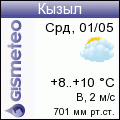|

Kyzyl Weather
| |
Quick Guide to Throat-singing
When you say "oo" or "ee," you produce different patterns of
overtones (harmonics), each in a different strength. Throat-singers screen out all but a
few overtones, making them audible as distinct notes, by tightening their throats so much
that only a tiny slit allows the sound through. This narrow slit also allows notes to be
sung for a long time.
Tuvan throat-singing can be divided into several styles—there is debate as to how
many there are. Five styles are sung in this album:
- Sygyt — a two-note style with the mouth shaped to say "er." It is
Ondar's specialty, and the style in which he was world champion from 1992-1995.
- Höömei — a three- (sometimes four-) note style with the mouth shaped to
say "oo." (This word is used in Tuva to denote both the three-note style, as
well as the entire range of throat-singing styles — a situation no more confusing
than saying letters that people send to each other are made of letters that form words!)
- Kargyraa — a two- (sometimes three- or four-) note style with the mouth
usually shaped to say "uh." Most remarkable is its "sub-harmonic"
quality, by which the voice emits "undertones" an octave (sometimes other
intervals) below the fundamental tone. This is Pena's specialty, the style in which he is
reigning world champion (1995), and the source of his name "Earthquake."
- Ezenggileer — this "saddle" technique evokes riding on horseback,
and involves a rhythmic pulse—you could think of it as a Tuvan verson of ska. Note
the end of Ondar's medley (track 5).
- Chylandyk — a combination of sygyt and kargyraa, this style is rarely heard
in Tuva. Nevertheless, Paul has mastered it and sings it in "Kargyraa Moan"
(track 10).
To the next page, the previous
page, or back to the Genghis Blues Lyrics Page.
|


